The F1 Goldendoodle, or the Groodle, is a dog that was once bred to outmatch the Cockapoo in its size. Ever since the 1990s, when this cross was first made, families all across the States have recognized the Goldendoodle as a beloved family dog.
This cross between the standard Poodle and the Golden Retriever may vary in size and coat traits, but generally speaking, they all are full of love.
The best of both worlds is combined. Meet the start of any cuddle session – the F1 Goldendoodle!
Highlights Of The Breed
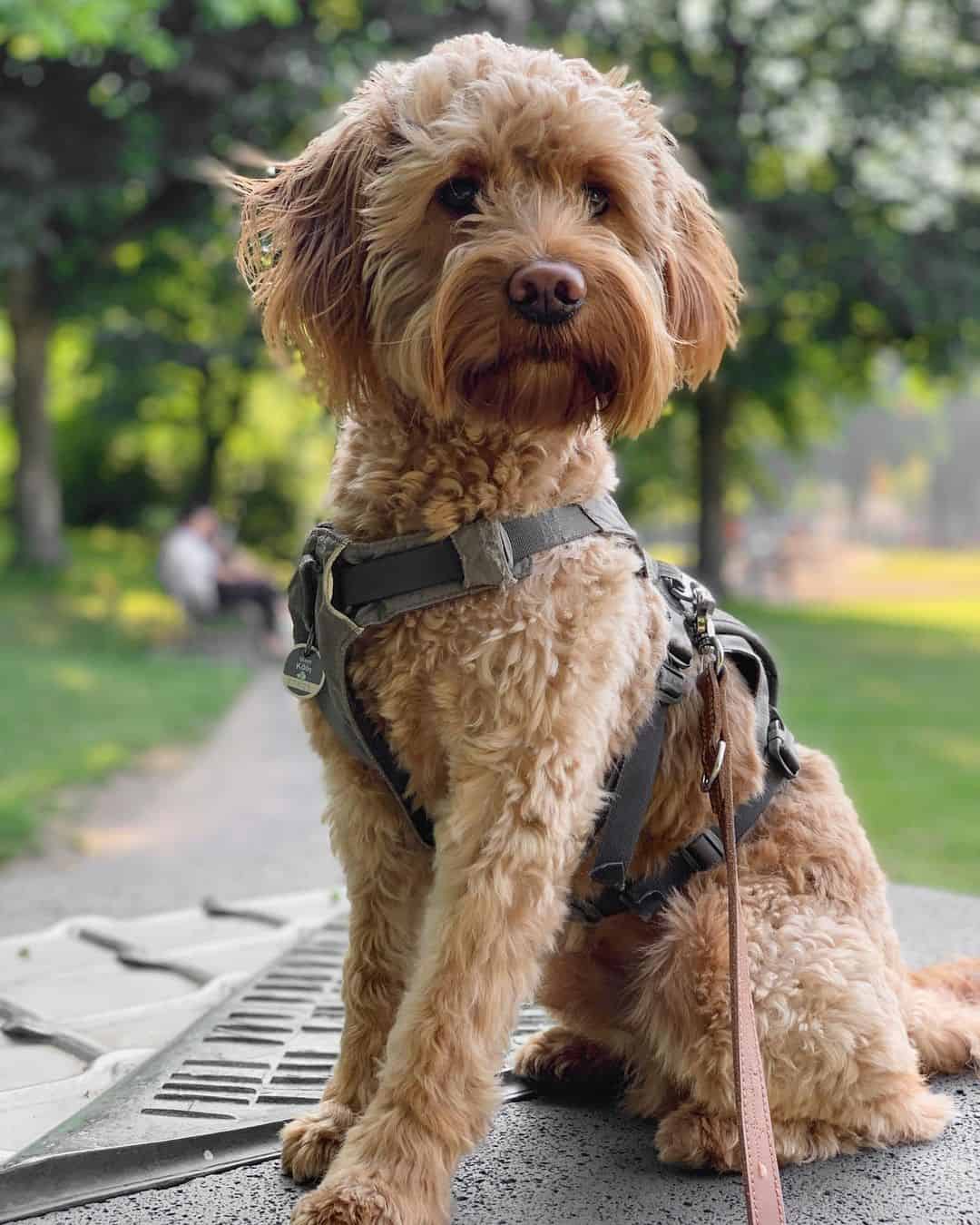
Photo from: @karl.the.doodle
• The Goldendoodles’ breed is a hybrid breed, not a true dog breed. They’re a cross of two specific breeds; the Poodle and the Golden Retriever. If you’re interested in owning a Goldendoodle puppy, you should know that not every Goldendoodle will look similar or the same because this cross doesn’t have a breed standard. Neither the temperament nor the personality will match other Goldendoodles. Each is a story of its own.
• This is the initial mix of Poodle and Golden Retriever called the f1 Goldendoodle. There are very few multigenerational crosses. In other words, rarely two Goldendoodles get crossed to create an f1b Goldendoodle or even a backcross.
• It’s a light to a non-shedding dog, but it’s still not hypoallergenic. This dog needs regular grooming and hair clipping. The short coat needs to be clipped every six to eight weeks, and brushed every few weeks.
• The Goldendoodle is not a watchdog or a guard dog. They’re not noisy, meaning they might not even bark if someone’s at the door.
• We do not recommend Goldendoodles to live in apartments, but in nice, fenced yards. They still have a medium energy level that needs to be wasted daily.
• Goldendoodles need 20 to 30 minutes of daily exercise.
• The Goldendoodle is a terrific family dog. These pups get along well with kids and other pets in the house.
• Goldendoodles are quite sociable, and you shouldn’t keep them away from the family. They’re not supposed to live in a kennel or outside. They’re house dogs and love to be included in everyday events.
• Goldendoodles are prone to suffering from separation anxiety if you leave them alone for too long.
• They’re a good choice for people with allergies.
• You can buy a healthy F1 Goldendoodle from a reputable breeder who runs tests on many genetic diseases that could be passed down to the puppies from the parents.
History Of The F1B Goldendoodle

Here’s a Doodle that’s still fairly fresh and trendy. Back in the 1990s, soon after the birth of the Cockapoo and the Labradoodle, the Poodle and the Golden Retriever fell in love and gave us the first one of these Doodles, the Goldendoodle.
The whole point of producing the Goldendoodle was to create a large Doodle that has a low-dander, low-shedding coat, and the intelligence and friendliness of the Golden Retriever. Thus, the Goldendoodle was born!
The fact that they’re still young designer dogs means most of the puppies are the result of first-generation breeding. In other words, the purebred Poodle and the purebred Golden Retriever are the parent breeds. Rarely do two Goldendoodles get to be bred.
Even though the F1 Goldendoodle has become extremely popular, especially in Australia, there are still no official clubs that recognize them, not to mention the American Kennel Club (AKC).
Still, there are some online clubs of Goldendoodle lovers and owners that simply adore this adorable Doodle.
F1 Goldendoodle vs F1b Goldendoodle
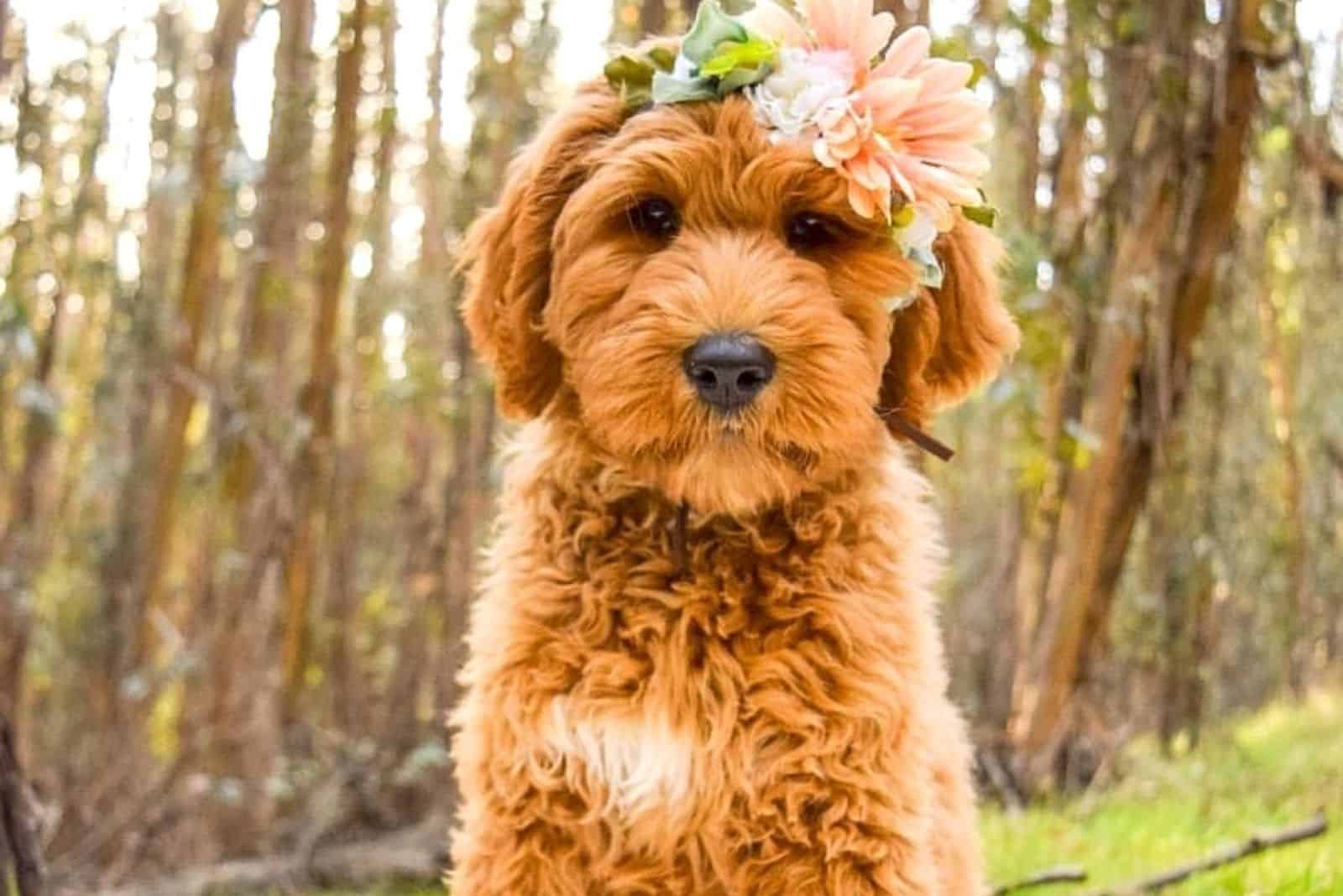
The F part of the word stands for filial, which is a way to denote generation.
The F1 means first generation Goldendoodle.
This is the initial cross, meaning one parent will be a purebred Golden Retriever while the other will be a purebred Poodle.
The F1 Goldendoodle is the best choice for dog lovers who love the other side in the Doodle combination since many Golden Retriever traits are preserved in their personality and appearance.
The F1 Goldendoodle has a loose, wavy coat that is not hypoallergenic. They still shed a bit, which is less than a purebred
Golden Retriever, but more than other Goldendoodle generations.
The meaning of F1B is the same as F1, except the letter b stands for backcross. Backcross means that the F1 Goldendoodle is backcross bred with a purebred parent breed.
In other words, the F1B Goldendoodle is 75% Poodle and 25% Golden Retriever. In order to get the F1B Goldendoodle, you will need to breed the F1 Goldendoodle and backcross it with a purebred Poodle or a purebred Golden Retriever. Usually, breeders choose the Poodle because of the non shedding and hypoallergenic coat traits.
Breeding the F1 Goldendoodle with a purebred Poodle gets us our F1B Goldendoodle.
The F1B Goldendoodle and the F1 Goldendoodle will result in the F2B Goldendoodle.
The F1B Goldendoodle may breed with a Poodle and create other multigen puppies, such as the F1BB Goldendoodle.
It does sound confusing at first, but wait until you hear about the rest of the generations.
Differences Between F1 Vs F1B Goldendoodle
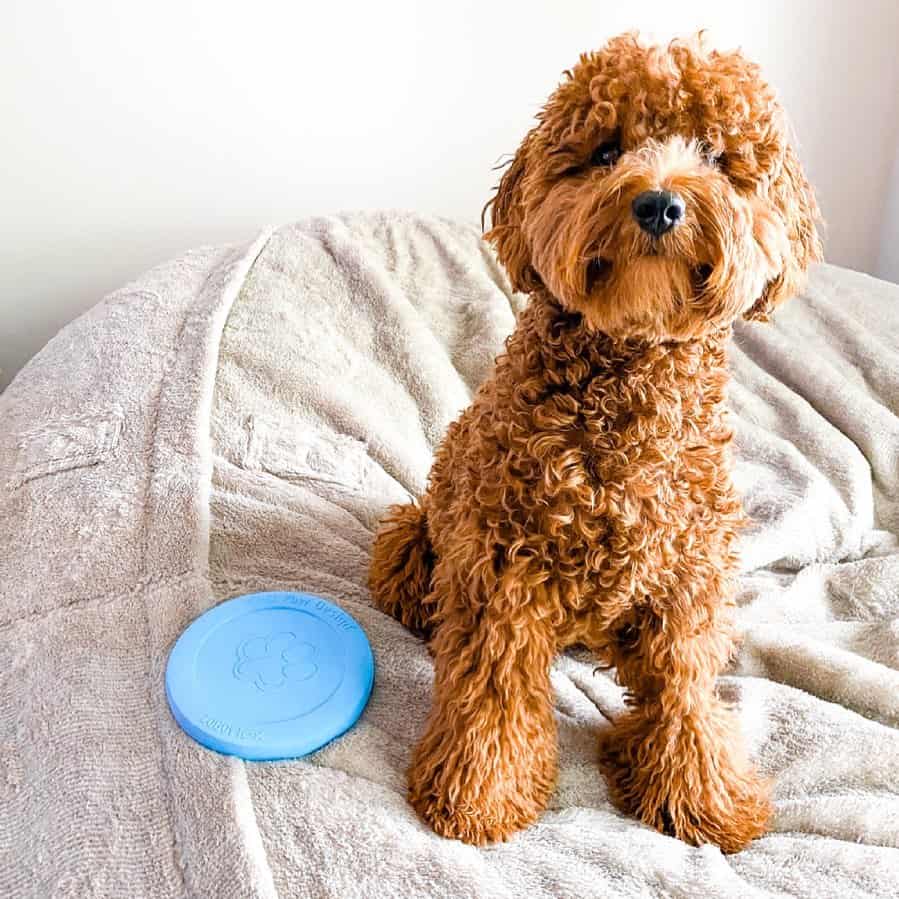
Photo from: @koa.the.cockapoo
So, are there any differences between the F1 Goldendoodle and the F1B Goldendoodle?
Yes, there are significant differences between these hybrids. The F1 Goldendoodle is 50% Poodle vs the F1B Goldendoodle, which is 75% standard Poodle. The breeders like to get a breed that has more Poodle genes because of the non shedding traits. The F1 Goldendoodle will shed more, but it will be less hypoallergenic. They will also have a better health status, thanks to hybrid vigor.
On the other hand, the F1B Goldendoodle will have a wavy or a curly coat that sheds less, but is more hypoallergenic.
In general, many dog owners will choose the F1B Goldendoodle vs the F1 Goldendoodle because they want a dog with a coat that sheds less and doesn’t give them allergies. However, the downside of an F1B Goldendoodle is that the more non shedding the coat is, the more you will have to groom your Goldendoodle to prevent tangles and mattes.
The plus side of owning a F1 Goldendoodle is that they will probably inherit the most hybrid vigor qualities between two purebred dogs. Hybrid vigor means that the first generation puppy, the F1 Goldendoodle, will be healthier than the purebred parents.
Do F1 Goldendoodles Shed?
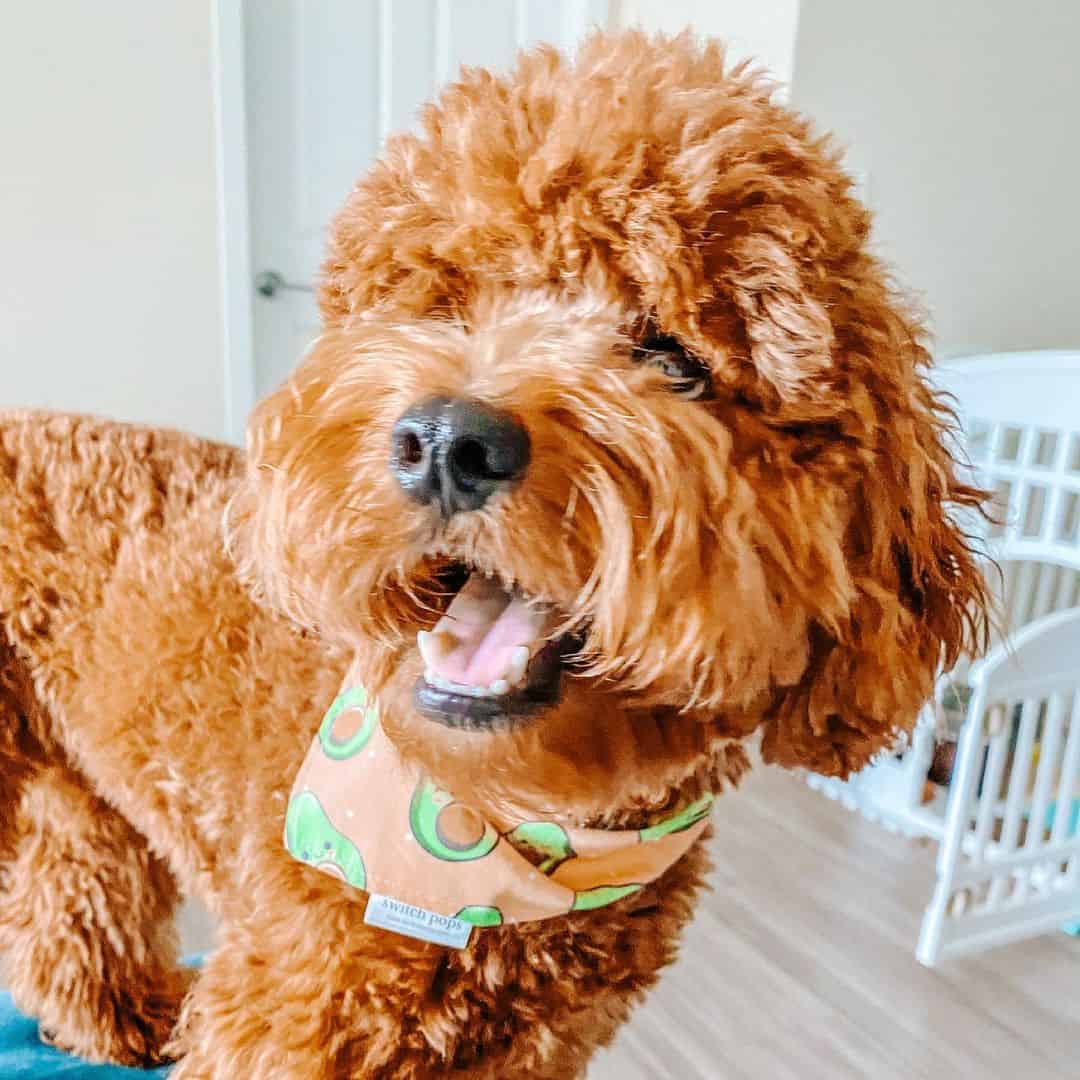
Yes, there are Goldendoodles that shed, but it all depends on their coat type. The closer the coat is to a Poodle parent, the less likely they are to shed.
The F1 Goldendoodle has a 50:50 chance of being a little shedding monster. However, if the puppy inherits more Poodle traits, he shouldn’t shed that much. More Golden Retriever traits mean that the Goldendoodle puppy will shed more.
It’s simple math!
Mini F1 Goldendoodle
A mini F1 Goldendoodle is a cross between a Golden Retriever and a miniature Poodle. Most mini F1 Goldendoodle puppies will reach an average weight of 30 to 50 pounds. However, this is quite predictable and can’t always be said for sure.
The mini F1 Goldendoodle coat varies in the amount of curls. These puppies are usually slightly wavy to slightly curly. They develop more curls or a shaggy coat when they reach full maturity.
The mini F1 Goldendoodle is a low-shedding hybrid, which generally sheds less than the Golden Retriever parent. But, we can’t guarantee that this puppy will be a non-shedding and hypoallergenic one.
Red F1 Goldendoodle
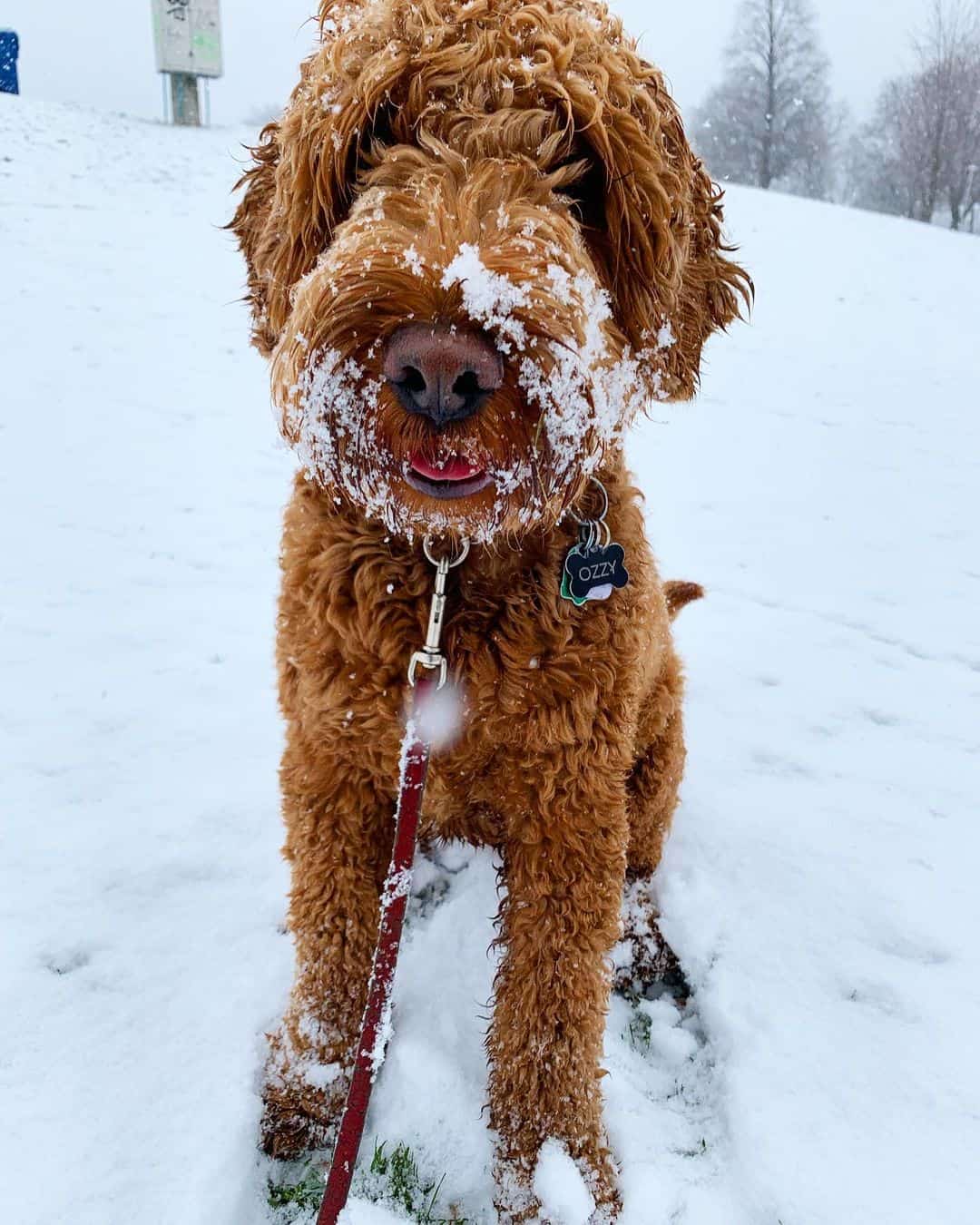
Photo from: @yellow.brick.dood
The red color is diluted from the black color. It’s quite rare for a Goldendoodle to carry a true red gene. You will need two red parents to get a red puppy. These dogs are hard to find, and they may be considered rare Goldendoodles.
Only a few breeders in the world carry the true red bloodline.
What’s so specific about the red F1 Goldendoodle is that they change color. This means that their coat color changes because one of the parents is a Poodle, and Poodles come in a variety of coat colors.
Hair and fur colors are the result of several different genes called phenotypic genes. These genes control the skin, eye, and hair color. Each Goldendoodle will inherit a lot of mixed genes from both parents.
Black F1 Goldendoodle
F1 Goldendoodles nearly always turn out to be brown or cream-colored. The black F1 Goldendoodle has become quite sought after. But, because of the color genetics, it’s still very hard to find one of these puppies.
So, yes, you can say black F1 Goldendoodles are rare.
The chances of getting a black Goldendoodle will increase if the breeder breeds the second or third generation puppies. If you cross a black Goldendoodle parent with a black Poodle, the result will almost always be all black puppies.
Second Generation Goldendoodles And F3 Goldendoodles
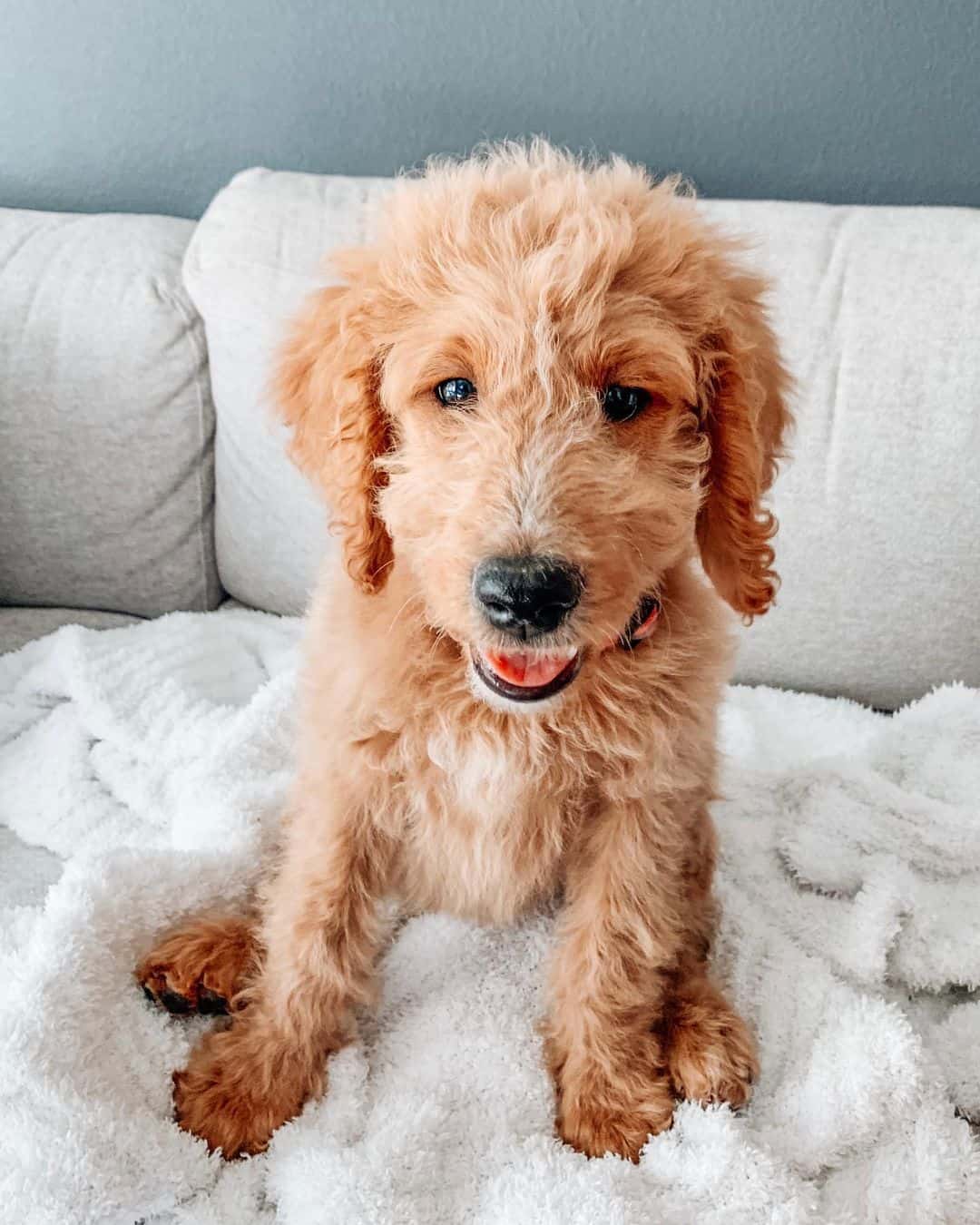
Photo from:@freiathedoodle
The second generation Golendoodles, or F2 Goldendoodles, are a mix of two F1 Goldendoodles. Due to the way genetics works, you can end up with a puppy fully resembling a Golden Retriever or fully resembling a Poodle.
The third gen Goldendoodle, the F3 Goldendoodle, is produced by breeding an F1B with an F2B, an F1B with an F1B, two F3s, two F2Bs, or an F2 to an F2. The breeders call them multigenerational Goldendoodles. At this point, traits from either lineage can be emphasized either positively or negatively.
F1 Goldendoodle Size
All f1 Goldendoodles vary in size. It’s still a fairly young designer dog, and dog breeders don’t have a standard for the dog’s appearance, nor do they try to make one. Usually, this hybrid comes in three different sizes: miniature, small standard, and large standard.
The mini Goldendoodle is the result of crossing a miniature Poodle or Toy Poodle with a Golden Retriever. They range in size from 13 to 20 inches in height, and 15 to 35 pounds in weight.
The small standard or medium Goldendoodle has an average height of 17 to 20 inches, and weighs 40 to 50 pounds.
The large standard is 20 to 24 inches tall, and weighs 50 to 90 pounds. The smallest of all Doodles is the teacup version, but breeding them is considered faulty and unethical.
Personality: What Are F1 Goldendoodles Like?
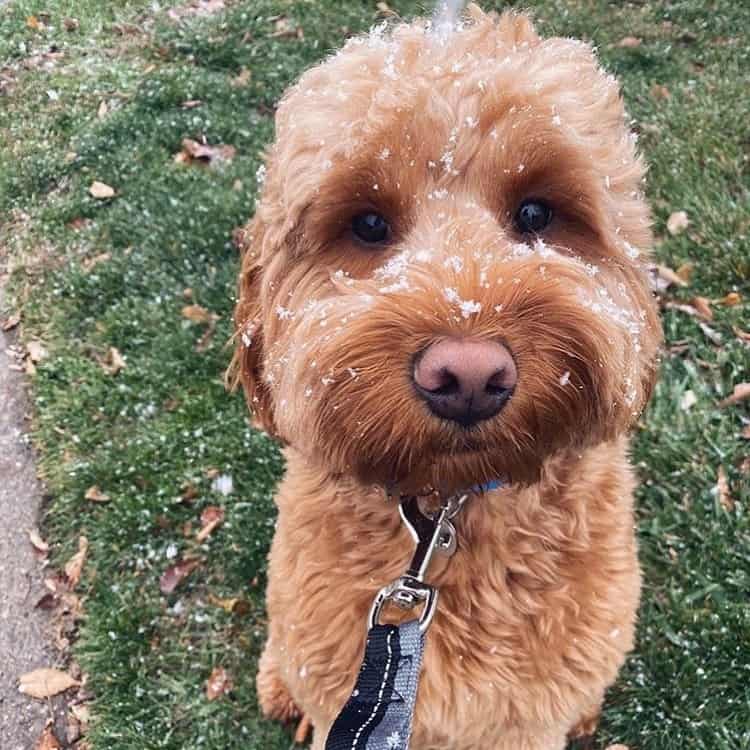
Photo from: @doodle_dailyig
The Goldendoodle did not become so popular just for nothing. His positive personality traits are numerous. Everywhere these dogs show up, they’re in the center of attention being friendly, intelligent, and loving little teddy bears.
This hybrid dog is a gentle soul, and quite patient. It makes a wonderful family addition. With proper training, these dogs can be very obedient.
They have a playful side, but they can also act naughty if they want to.
The Goldendoodle’s temperament is affected by many factors including heredity, training, and socialization. Puppies with a good temperament are curious and playful. They easily approach new people.
When choosing your Goldendoodle, choose a puppy in the middle… one that’s not too shy, but also not too tough. Try to see if meeting the purebred parents is possible in order to see how the puppies will turn out to be.
All generations of Goldendoodles need early socialization, meaning you should expose them to new people, sights, experiences, and sounds daily, starting in early puppyhood. Proper socialization ensures that your Goldendoodle puppy will grow up to be a well-behaved dog.
Health Issues: Common Doodle Problems
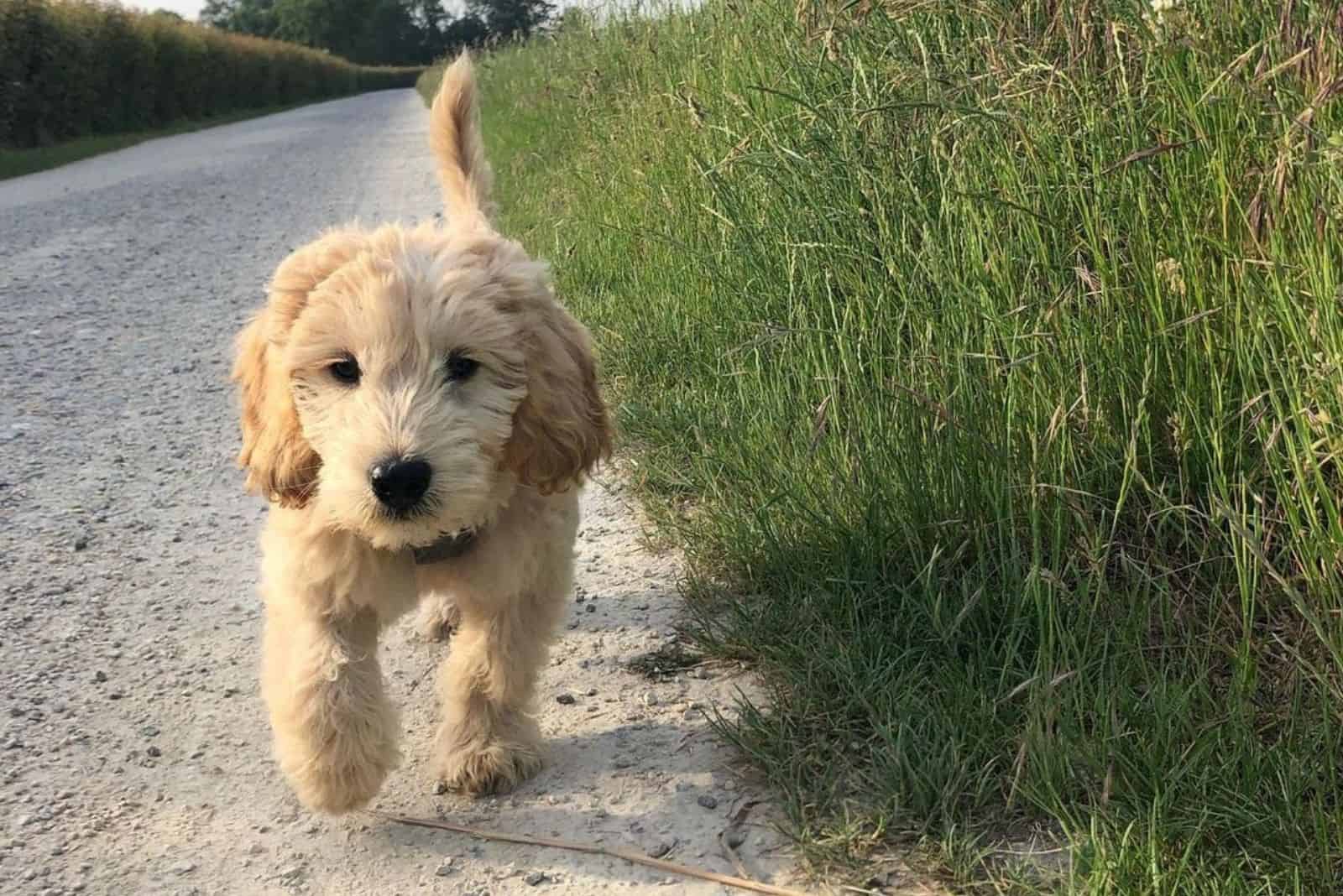
Goldendoodles are generally healthy, but there’s no such thing as a 100% healthy dog. Just like the Bernedoodle and other Doodles, the Goldendoodle is prone to certain health issues.
When choosing a puppy, you should find a good breeder who will show you health clearances on demand for both parents and the puppy. These health clearances are proof that the dog has been tested for some health conditions.
You should expect to see clearances from the Orthopedic Foundation for Animals (OFA) for hip dysplasia, with a score of fair or better, including clearances for elbow dysplasia, hypothyroidism, and Von Willebrad’s disease. You should also expect to see clearances from Auburn University for thrombophilia, and from the Canine Eye Registry Foundation (CERF) claiming that their eyes are normal.
A future Goldendoodle owner should know that these dogs are prone to:
• Patellar Luxation: Or slipped stifles is a common problem with small dogs. The patella is the kneecap, and luxation means dislocation such as a bone at a joint. Patellar luxation often strikes the hind legs causing the knee joint to slide out of place; thus, causing pain. It can be crippling pain, even though many dogs live with it.
• Ear Infections: Floppy ears are a sign that your dog may be prone to ear infections. They trap moisture inside, making it the perfect area for bacteria to develop. Check those gorgeous silky ears regularly to prevent infections.
• Hip Dysplasia: This is an inherited condition, which can also be triggered by malnutrition. The thighbone doesn’t fit snugly into the hip joint, which causes pain and lameness on one or both hind legs. The best way to get this diagnosed is by taking your dog to have X-ray screening. Dogs with hip dysplasia shouldn’t be bred.
• Elbow Dysplasia: This is similar to hip dysplasia. It’s also a degenerative disease caused by abnormal growth and development. The result is a malformed and weak joint. A dog suffering from this condition may develop arthritis or become lame. Treatment involves surgery, weight management, medical management, and anti-inflammatory medications.
• Progressive Retinal Atrophy (PRA): This is a family of eye diseases that involves the gradual deterioration of the retina. First, dogs become night-blind. Then, they lose sight during the day as the disease progresses. Still, many dogs, no matter if they’re sight-imapred, live a normal life if their surroundings stay the same.
• Von Willebrand’s Disease: This is a disease that strikes both humans and dogs. It is a disorder that affects the clotting process. An F1 Goldendoodle suffering from this condition will have symptoms like nosebleeds, bleeding gums, or prolonged bleeding after surgery, during heat cycles, or after whelping.
Von Willebrand’s disease is detected between three and five years of age, but unfortunately, it cannot be cured. Treatments such as cauterizing or suturing injuries, transfusions before surgery, and avoidance of specific meds can help.
• Allergies: These are quite common in all dog breeds, and the F1 Goldendoodle is no exception. There are three main types of allergies: food, contact, and inhalant allergies. Treatment for allergies varies, ranging from dietary restrictions, medications, and even environmental changes.
• Gastric Dilatation-Volvulus: Also known as bloat, this is a life-threatening condition that affects large and deep-chested dogs just like our F1 Goldendoodle! Never give your dog one big meal a day, or let it eat or drink rapidly before extreme exercises.
Bloat may strike anytime, but older dogs are more prone to it. GDV occurs when the stomach is distended with gas and air, and then it twists causing torsion. Dogs can’t belch or vomit to get rid of the excess air, and soon enough, the dog falls into shock.
If not treated immediately, it can be fatal. Symptoms of this condition include a distended abdomen, excessive salivating, and retching without throwing up. Your dog may act restless, lethargic, depressed, and weak. Seek immediate vet’s help if you spot any of these symptoms.
• Hypothyroidism: This is a disorder of the thyroid gland, which is responsible for conditions like epilepsy, alopecia, obesity, lethargy, hyperpigmentation, pyroderma, etc. The treatment includes medication and diet.
Taking Care Of A Full Grown F1 Goldendoodle
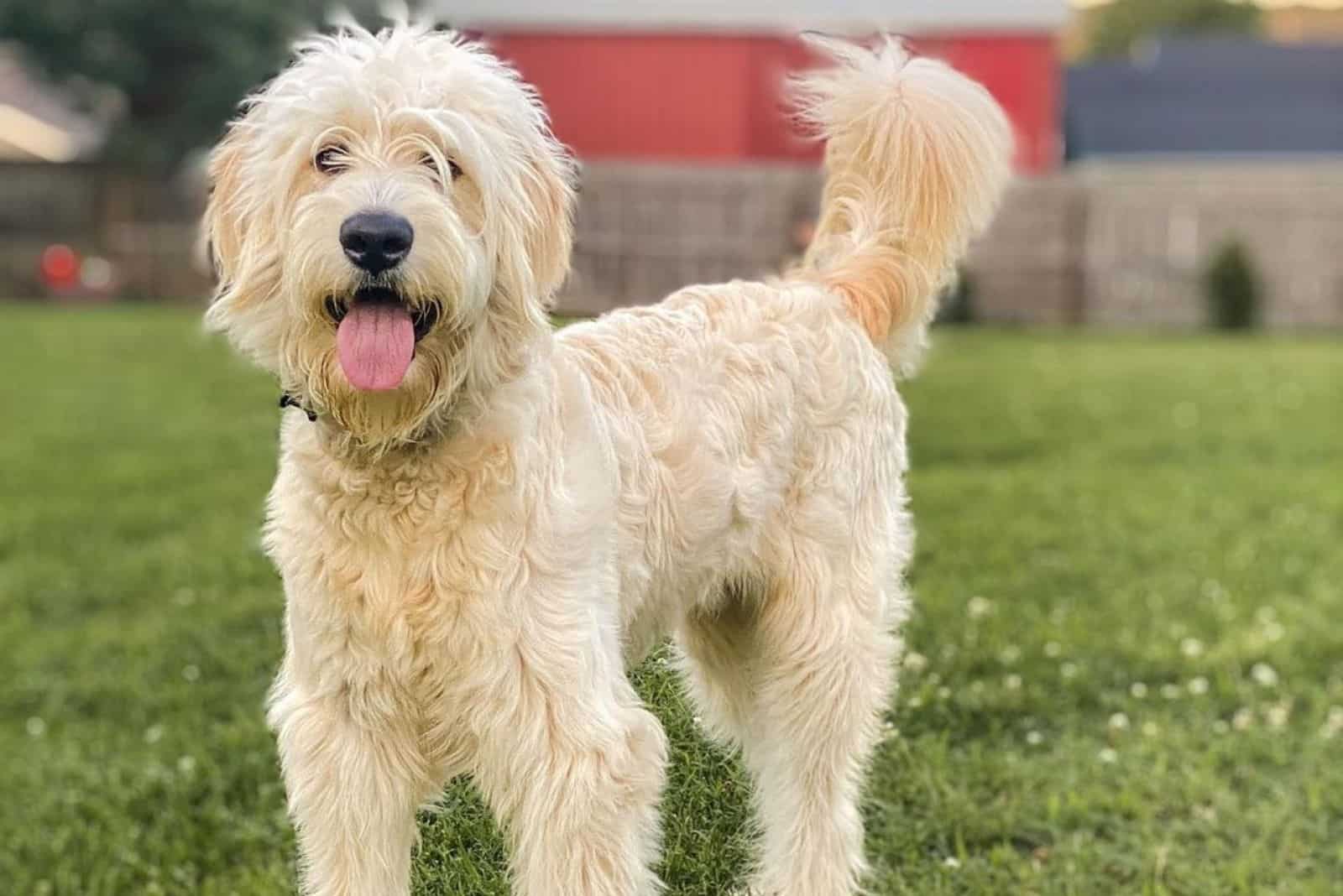
Thanks to two intelligent parents, the Golden Retriever and the Poodle, the Goldendoodle is a delight to be trained. They’re also very eager to please their owner, which makes them the perfect dog for first-time owners / trainers.
You should train the Goldendoodle by using a positive reinforcement approach in order to avoid harsh corrections, which could damage the dog’s confidence.
Socialization is an important process in every dog’s life. For a shy breed like the F1 Goldendoodle, this is also a way of overcoming their shyness and timidity in order to have a fulfilling life.
Since the Goldendoodle has a medium energy level, they will need daily exercises in the back yard for 20 to 30 minutes. Otherwise, they could get bored. Don’t let them get bored; they will begin acting destructively. Also, don’t leave them alone for too long because they can develop separation anxiety.
The Goldendoodle is known for its love of swimming and water. Swimming is another excellent vent for their energy drive. Make sure you don’t live in a tiny apartment with no outdoor access if you want one of these pups. They can grow large, meaning they will require a lot of space to feel free.
Forget about living outside or in a dog kennel. This is a dog that needs his family all the time. They belong in a house, snuggling with you.
Standard F1 Goldendoodle Feeding Requirements
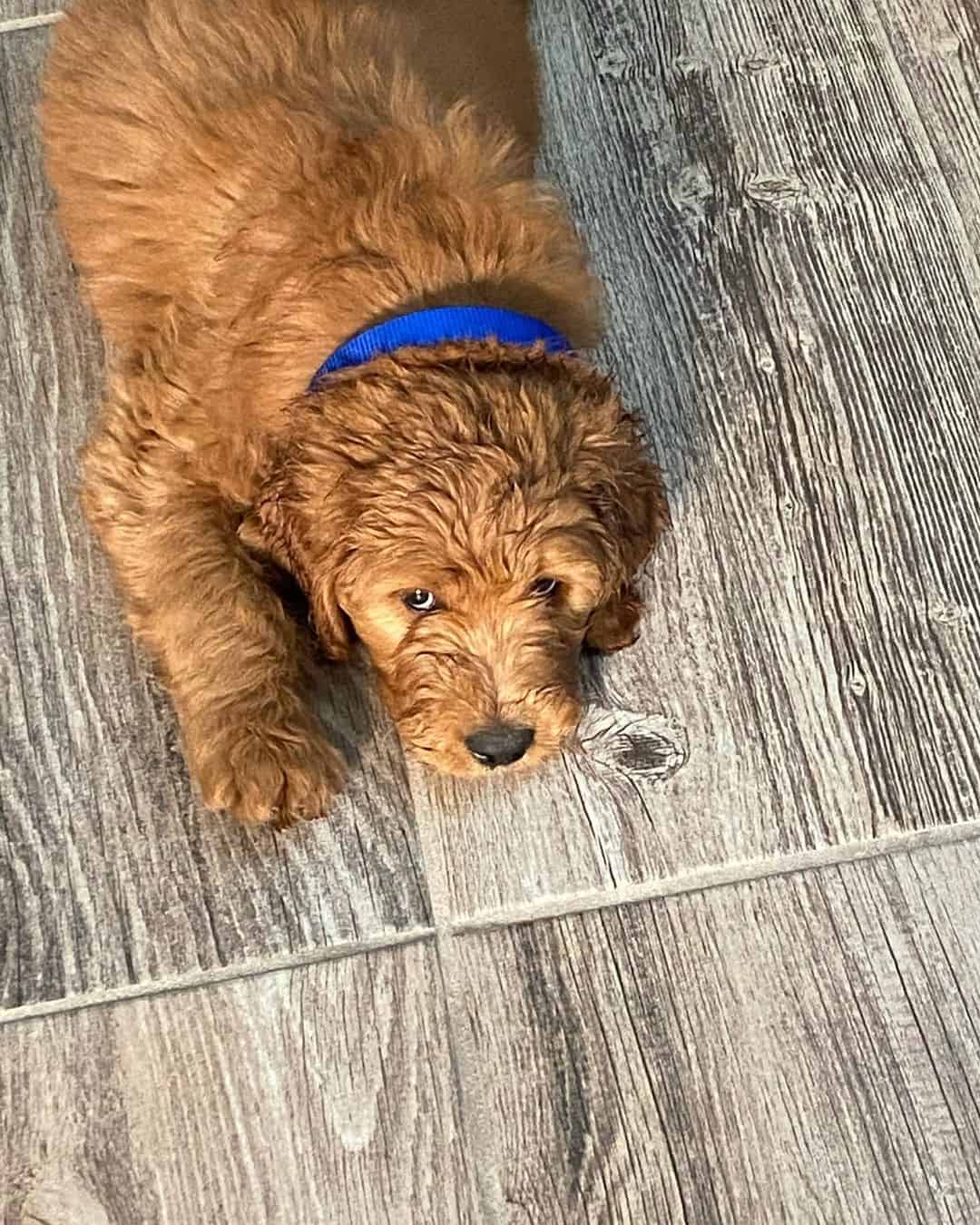
Photo from: @ginger_thegoldendoodle_
The recommended daily amount for F1 Goldendoodles is 1 to 4 cups of dog food, depending on adult size. These cups should be divided into multiple meals.
How much your adult dog eats depends on the dog’s size, age, build, metabolism, and activity. Not all dogs eat the same, just like humans. A highly active dog will need more food than a small pooch with medium energy.
The quality of dog food makes a difference. The better the food is, the more nourishing it will be.
You should keep your F1 Goldendoodle in good shape by feeding him twice a day and measuring his food. If you suspect that your dog is overweight, check if you can see his waist. Then, feel out his ribs without having to press hard. If you can’t feel his ribs, then your dog should have less food and more exercise.
Since one of the Goldendoodle parents, the Golden Retriever, is prone to bloat or gastric torsion, you should be extra careful and let your dog eat small meals during the day instead of a large one.
F1 Goldendoodle Shedding, Coat Color, And Grooming

The Goldendoodle has a wavy to curly coat type, which is around two to three inches in length. The hair is longer on the tail, body, ears, and legs (which can be slightly feathered). The hair on the muzzle and on the head is a bit shorter.
People suffering from mild allergies as well as from severe allergies might find the F1 generation Goldendoodle as being a great family member that doesn’t trigger those allergies. Even though they’re not hypoallergenic, they still are less shedding than their purebred parents.
The Goldendoodle’s coat comes in various colors – black, white, copper, cream, grey, golden, apricot, and red. However, golden is the most common color. White is usually on the feathering. This crossbreed’s coat tends to lighten with age.
Even though they’re light to non-shedders, the Goldendoodle still needs some grooming to keep that coat nice and shiny.
Dog owners usually clip the coat for easier maintenance. However, if you keep it natural, then expect to brush it once every week or two. A clipped Goldendoodle needs good brushing every few weeks.
The Goldendoodle needs a bath only when it’s absolutely necessary or else their skin will lose the much-needed moisture and natural oils.
Another important step of grooming is brushing the dog’s teeth. This should be done two or three times a week to remove tartar buildup and bacteria. Daily brushing is perfect if you can commit to it.
Dogs usually wear down their nails, but when they don’t, you need to step in and trim them. Nails should be trimmed once or twice a month. If you can hear them clicking on the floor, it means they’re too long.
You must be careful when trimming a dog’s nails because dogs have blood vessels in their nails. If you cut too far, you can cause them to bleed, and your pup may not cooperate the next time trimming is needed. If you’re not an experienced groomer, ask a professional to help in order to avoid potential accidents.
Dog ears, especially if they’re floppy like the F1 Goldendoodle’s, should be checked weekly for redness and bad odor, which are the signs of infection. When you check your dog’s ears, wipe them out with a damp cotton ball and use a pH-balanced ear cleaner. Never insert anything inside the ear canal; only clean the outer part of the ear.
Brushing is a highly important task that you must do in order to prevent tangles and coat matting. What you should do is accustom your Goldendoodle to being brushed regularly, starting in its puppyhood. Once you get them used to being brushed, it will only get easier in the future.
As you brush, check for any signs of sores, redness, rashes, tenderness, or inflammation on the skin, nose, mouth, eyes, and feet. Eyes should be clear and without discharge.
If you spot a sign of infection early, you’re halfway there to treating it completely.
F1 Goldendoodle, Children, And Other Pets

The f1 Goldendoodle is truly a wonderful family pet, especially if they take after the Golden Retriever parent. They’re patient pups that are very gentle and prepared to play with kids of all ages.
Still, like with all other dog breeds, you must prepare the kids to handle the puppy correctly. This should avoid any possible injuries that the puppy could get or make.
Even though they’re sweethearts, they shouldn’t be trusted alone with kids. In fact, no dog should be trusted alone with kids, even a properly socialized one.
F1 Goldendoodle Puppies For Sale Near Me
Many people purchase the F1 Goldendoodle without even knowing how many responsibilities come with them. Sure, they’re terrific buddies, but for some people, being that good of a friend isn’t enough.
There are many f1 Goldendoodles in the shelters that are ready to be picked up and carried to their new forever home. If you believe you can be a good Goldendoodle owner, then you should consider adopting one from one of these shelters.
The most popular ones that carry f1 Goldendoodles are:
• Doodle Rescue and Rehomes Board
• Doods Needing Homes
• Poo-Mix Rescue
Final Words
The F1 Goldendoodle is one of the finest examples of cross breeding purebred dogs. This pioneer among Goldendoodles is a terrific family dog that is ready to help, love, and support you. What else do you need from a cuddly teddy bear like this one?

















